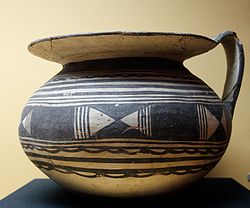- Daunia
-
The Daunia is a historical and geographical region in Apulia, southern Italy, mostly coincident with modern Province of Foggia. In ancient times, together with Peucetia and Messapia it formed the Iapygia.
Origins
Towards the late Bronze Age (11th-10th centuries BC), Illyrian populations from the eastern Adriatic arrived in Apulia probably using the narrow stretch of water between Albania and Italy.[1] The Illyrians in Italy created the Iapygian civilization, which consisted of three tribes: Peucetia, Messapi and the Dauni.[2]
It differentiated from the two other regions inhabited by the Yapiges by its relative distance from the Greek colonies, from which it had less connections. Having been also less influenced by the Campanian civilization, it had thus a more peculiar culture, featuring in particular the Daunian steles, a series of funerary monuments sculpted in the 7th-6th centuries BC in the plain south of Siponto, and now housed in the National Museum of that city. Particularly striking is Daunian pottery (as yet little studied) which begins with geometric patterning but which eventually includes crude human, bird and plant figures.
The main Daunian centers were Teanum Apulum (within the modern San Paolo di Civitate), Uria, Casone, Lucera, Merinum (Vieste), Monte Saraceno (near Mattinata), Siponto, Coppa Navigata, Cupola, Salapia (near Cerignola and Manfredonia), Arpi (near Foggia), Aecae (near Troia), Vibinum (Bovino), Castelluccio dei Sauri, Herdonia (Ordona), Ausculum (Ascoli Satriano), Ripalta (near Cerignola), Canosa di Puglia, Melfi, Lavello and Venosa.
See also
References
Categories:- Apulia
- Ancient peoples of Italy
- Illyrian tribes
Wikimedia Foundation. 2010.

